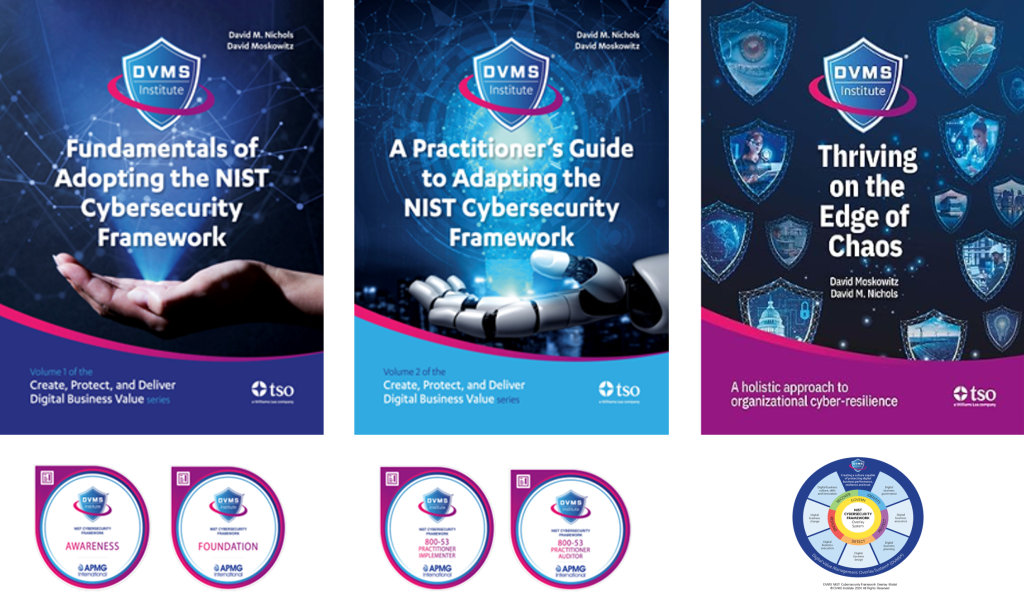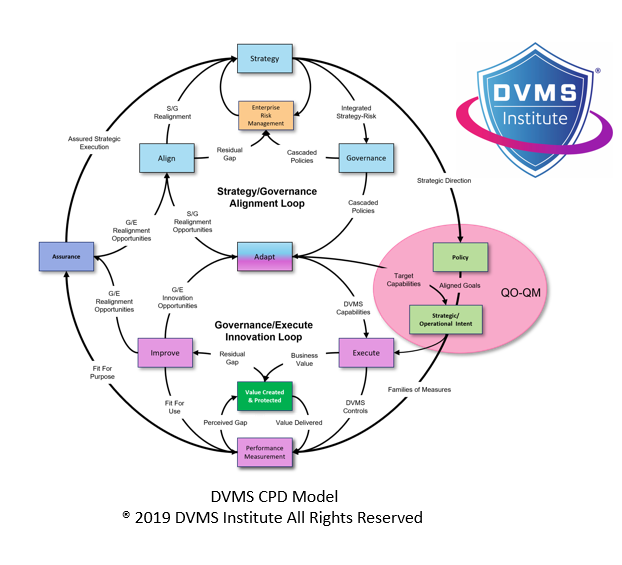Cyber Operational Resilience Starts with You – A C-Suite Leadership Imperative
Rick Lemieux – Co-Founder and Chief Product Officer of the DVMS Institute
The Unrelenting Digital Storm
We live in an era where businesses must navigate a digital ecosystem of volatility, uncertainty, complexity, and ambiguity (VUCA). In such an environment, threats multiply and evolve, becoming more sophisticated and persistent. A single breach or disruption can devastate operational continuity, reputation, and long-term viability. Cyber resilience — the ability to anticipate, withstand, recover from, and adapt to adverse cyber events — is no longer a defensive luxury. It is a foundational necessity for survival and prosperity in the digital age.
Cybersecurity Alone Is No Longer Enough
Historically, organizations approached cybersecurity as a preventative measure—a line of defense to keep bad actors out. But the presumption of absolute protection is now obsolete. But the presumption of absolute protection is now obsolete. No organization is immune. The question is no longer if a breach will occur but when. Therefore, the organizational mindset must shift from protection-centric thinking to resilience-centric execution. This means preparing for the inevitability of compromise and ensuring the ability to continue delivering value even under digital duress.
Resilience Is a Business Imperative, Not Just a Technical Goal
Cyber resilience transcends the IT department. It is a strategic objective with implications across governance, risk, compliance, operations, and customer trust. The NIST Cybersecurity Framework (CSF) 2.0 underscores this, defining six core Functions — Govern, Identify, Protect, Detect, Respond, and Recover — that any organization, regardless of size or sector, must address to manage cybersecurity risk effectively. These Functions integrate into enterprise-wide risk governance, directly tying cybersecurity activities to resilient digital business outcomes. Thus, resilience is critical to performance assurance, stakeholder confidence, and competitive advantage.
A Universal Threat Landscape Demands a Universal Response
Cyber resilience is not just a concern for Fortune 500 companies. Small businesses, local governments, non-profits, and startups are equally, if not more, vulnerable. Smaller organizations often lack dedicated cybersecurity resources and can suffer disproportionately from disruptions. CSF 2.0 explicitly accommodates this diversity, offering flexible guidance tailored to risk appetites, mission requirements, and maturity levels. Whether you’re a boutique firm or a global conglomerate, resilience is both scalable and essential.
The Cost of Non-Resilience
Organizations that neglect resilience planning face stark consequences. Beyond the direct costs of a breach — data loss, legal penalties, or regulatory violations — there are long-term implications: erosion of brand trust, loss of investor confidence, reduced market competitiveness, and compromised stakeholder relationships. For public institutions, failures in resilience can equate to public safety risks and loss of societal trust. In contrast, resilient organizations are better positioned to recover from setbacks and often outperform competitors by demonstrating reliability, agility, and foresight.
Leadership, Culture, and Continuous Learning: The Pillars of Resilience
Achieving cyber resilience is not a one-time project but a continuous, organization-wide commitment. It requires a learning culture, accountable leadership, and systems thinking. The most resilient organizations reframe adversity as a catalyst for growth. They recognize that structure and behavior are intertwined — just as a Formula 1 car must be engineered for high performance, an organization’s culture, processes, and policies must also be aligned for resilience.
Culture plays a central role. The DVMS Institute’s work in “Thriving on the Edge of Chaos” emphasizes that culture is not merely a byproduct of structure but a lever of change. It is how organizations express their worldview, manage risk, and collaborate across silos. Resilient culture demands decentralized decision-making, transparent communication, and iterative learning — not rigid hierarchies or reactionary fixes.
The DVMS: Powering Resilient Outcomes at Any Scale
The Digital Value Management System® (DVMS) empowers organizations with a holistic and culture-aligned system capable of coordinating adaptive, governance, resilience and assurance actions across a complex digital ecosystem. Achieving true cyber resilience requires seamless alignment between organizational strategy, governance, and operations underpinned by a culture dedicated to sustaining and continuously innovating organizational digital value.
The DVMS positions cyber resilience as a strategic, enterprise-wide capability powered by the DVMS CPD, ZX and 3D Knowledge models.
This systems-based approach to cyber operational resilience demands active engagement from all members of a digital ecosystem. Each member plays a distinct role in proactively identifying and mitigating the systemic risks that threaten digital business operations.
These capabilities enable organizations to identify and close performance gaps, adapt to emerging risks, and ensure that resilience is not siloed within IT but embedded into every operational layer. The DVMS also leverages concepts from complexity science and systems thinking, allowing organizations to “coax” change through targeted interventions rather than wholesale overhauls. It is not a one-size-fits-all solution; it is an “adaptable-by-all” approach that empowers leadership teams to foster a culture of resilience, accountability, and continual innovation.
This adaptive, forward-looking approach to governance, resilience, and assurance positions businesses to:
- Maintain Operational Stability Amidst Constant Digital Disruption
- Drive Agility and Trust Across Your Digital Ecosystem
- Satisfy Critical Regulatory and Certification Requirements
- Leverage Cyber Resilience as a Competitive Advantage
NIST CSF 2.0: A Strategic Foundation
The NIST CSF 2.0 further supports the resilience journey by offering a structured outcomes taxonomy, profiles for setting and assessing maturity goals, and tiers for benchmarking governance rigor. It is not prescriptive but descriptive, making it ideal for integration with systems like the DVMS. Together, they form a strategic engine for digital business assurance, guiding organizations to align their cybersecurity practices with mission-critical outcomes.
A Call to Action: Make Resilience Your Strategic North Star
The digital storm is not subsiding. If anything, it is intensifying. As cyber threats become more frequent, disruptive, and costly, organizations must pivot from isolated defenses to integrated resilience. This shift requires reimagining how we govern, operate, and innovate. It demands new mental models and bold leadership willing to view cybersecurity not just as a line item in the budget but as a lever of enterprise value.
Whether you are a C-suite executive, board member, risk officer, or operational leader, now is the time to prioritize resilience. It is the currency of trust, the shield of performance, and the compass guiding organizations through complexity. Cyber resilience is not just about surviving the chaos but thriving within it.
About the Author

Rick Lemieux
Co-Founder and Chief Product Officer of the DVMS Institute
Rick has 40+ years of passion and experience creating solutions to give organizations a competitive edge in their service markets. In 2015, Rick was identified as one of the top five IT Entrepreneurs in the State of Rhode Island by the TECH 10 awards for developing innovative training and mentoring solutions for boards, senior executives, and operational stakeholders.
In today’s digitally driven economy, cyber disruptions are no longer an “if” but a “when.”
The DVMS Institute’s Certified Training Programs teach organizations the skills to build a Holistic and Culture-Aligned System capable of coordinating Adaptive, Governance, Resilience, and Assurance actions across a Complex Digital Ecosystem.
Achieving true cyber resilience across a complex digital ecosystem requires seamless alignment between organizational Strategy, Governance, and Operations, underpinned by a culture dedicated to sustaining and continuously innovating organizational digital value.

The DVMS positions cyber resilience as a strategic, enterprise-wide capability powered by the Institute’s CPD, Z-X, and 3D Knowledge models.
This systems-based approach to cyber operational resilience demands active engagement from all members of the Digital Ecosystem, with each member playing a distinct role in proactively identifying and mitigating the systemic risks that threaten digital business operations.
This adaptive, forward-looking approach to Governance, Resilience, and Assurance (GRA) positions businesses to:
- Maintain Operational Stability Amidst Constant Digital Disruption
- Drive Agility and Trust Across Your Digital Ecosystem
- Satisfy Critical Regulatory and Certification Requirements
- Leverage Cyber Resilience as a Competitive Advantage
DVMS Explainer Videos
- Architecture Video: David Moskowitz explains the DVMS System
- Case Study Video: Dr. Joseph Baugh Shares His DVMS Story.
- Overlay Model – What is an Overlay Model
- ZX Model – The MVC’s that power operational resilience
- CPD Model – Adaptable governance and assurance
- 3D Knowledge Model – Enabling holistic organizational learning
- FastTrack Model – A phased approach to cyber resilience
Digital Value Management System® is a registered trademark of the DVMS Institute LLC.
® DVMS Institute 2025 All Rights Reserved



